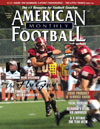AMERICAN FOOTBALL MONTHLY THE #1 RESOURCE FOR FOOTBALL COACHES
Article CategoriesAFM Magazine
|
Focal Tackling - Using Your Eyes to Make PlaysWhy many defensive coordinators teach tandem tackling.by: Mike Kuchar Senior Writer, American Football Monthly © More from this issue We know that football has become a game played in space – there is no denying that. In the last issue of AFM, we discussed the way that tackling has morphed from a semi-barbaric method of driving someone into the ground, into a more detailed approach based on where you are in the field. Because spread schemes get their athletes the ball in space, most defensive coaches preach to their players to “leverage” the ball or keep it inside the numbers and know where your help is. Tackling used to be all about bodying up a ball carrier and running your feet through the tackle, but because of the development of open offenses, now D-coordinators are combating that problem less with technique and more with tackling in tandems. There are still plenty of coaches placing an emphasis on the fundamentals of tackling – and most of them a....The full article can only be seen by subscribers. Subscribe today!
|
|
|||||||
| HOME |
MAGAZINE |
SUBSCRIBE | ONLINE COLUMNISTS | COACHING VIDEOS |
Copyright 2025, AmericanFootballMonthly.com
All Rights Reserved





